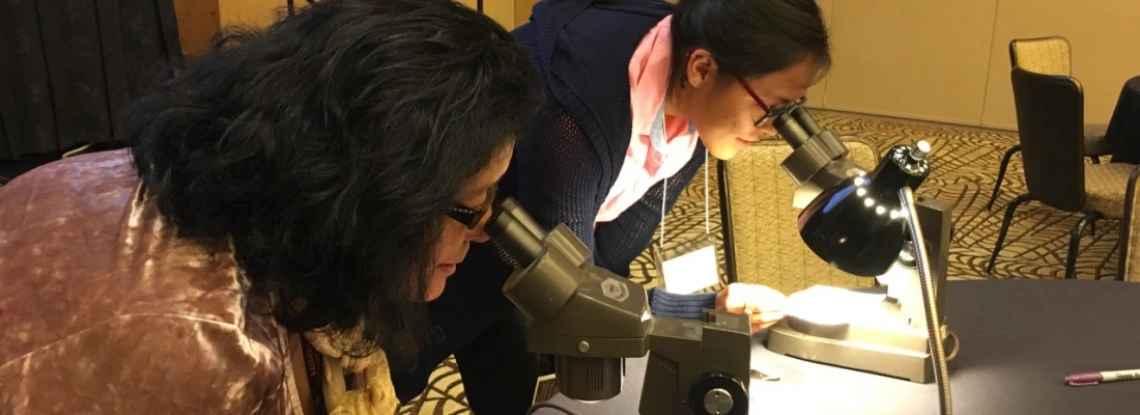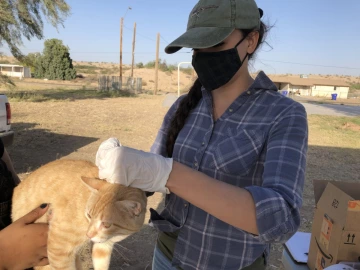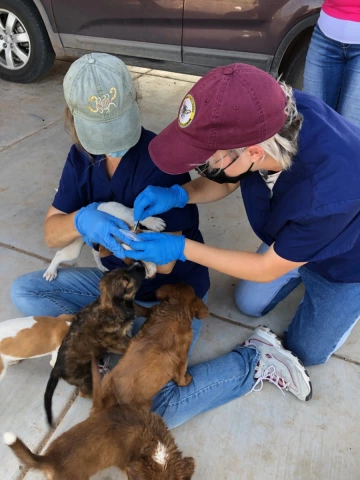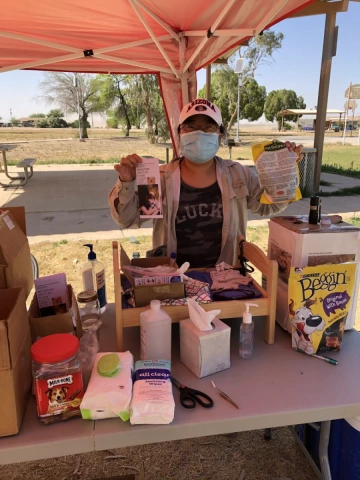UArizona Partnership with Tribal Communities Knocks Out Pests, Not the Environment

Community members take part in an Earth Day event with hands-on activities for children and adults to identify and learn how to prevent or manage common pests.
As the number of mosquitoes caught in traps set in the Ak-Chin Indian Community started to climb this spring, tribal professionals and staff sprang into action.
But instead of taking a broad approach of random pesticide fogging, they deployed the equivalent of surgical strikes.
They used techniques adopted in collaboration with the University of Arizona Public Health Integrated Pest Management Leadership Team: larvicide in traps and water breeding sites to kill mosquitoes before they hatch; monitoring and identifying specific species; and targeted applications to kill adult mosquitoes while leaving beneficial insects unharmed.
“We waited for the right time to do the larvicide treatments,” said Theodore Puetz, pesticide control specialist with the Ak-Chin Indian Community, south of Phoenix. “We knocked down the problem using different modes of action. And we accomplished the 1-2 punch of protecting our community’s health –from mosquito-borne disease– and reducing the use of pesticides.”
Another success story in an ongoing collaboration between the UArizona Integrated Pest Management (IPM) team and Native American communities in the state.
Since 2018, the IPM team has partnered with 15 of Arizona’s 22 federally recognized Native American Nations and has reached nearly a quarter of a million residents through its programs, trainings, and information, said Dr. Shujuan (Lucy) Li, an Associate in Extension and leader of the team.
“We work with the tribal experts and professionals,” said Li, who is with the Department of Entomology in the UArizona College of Agriculture, Life and Environmental Sciences. “Once we have their input, we tailor our program to each tribe, so we can help them fulfill their needs.”
What is IPM?

 Integrated pest management is, at its heart, a science-based strategy to manage and prevent pests – mosquitoes, cockroaches, ticks, bed bugs, and the like – by using environmentally friendly methods and minimizing risks to humans.
Integrated pest management is, at its heart, a science-based strategy to manage and prevent pests – mosquitoes, cockroaches, ticks, bed bugs, and the like – by using environmentally friendly methods and minimizing risks to humans.
In agriculture, IPM principles could involve rotating crops, growing pest-resistant produce, removing pests through mechanical methods, and adjusting planting and harvesting times to avoid infestations.
In school, community, and home settings, it might involve using traps, creating barriers, and cleaning up potential pest sources, such as cardboard, debris, or old tires – “a perfect habitat for mosquitoes,” Li said. It would entail working with local animal control officials and communities to put anti-tick collars on dogs and conduct spaying and neutering.
IPM involves accurately identifying the species of pest so effective measures and specific chemicals, if necessary, can be used.
What it doesn’t involve is general, broad-spectrum pesticides.
“Say you have a cockroach infestation,” said Africa Dorame-Avalos, with the Inter Tribal Council of Arizona. “You can take out a can of Raid, but it’s not going to eliminate the problem. Pesticides have gradually lost their effectiveness, and pests have developed resistance. It is important to eliminate the source that is attracting a specific pest, whether it’s food, shelter, water, landscaping, or even location.”
Dorame-Avalos is pesticide program manager for the Inter Tribal Council, which collaborates with the University of Arizona team and provides services to tribes across the state. Dorame-Avalos credits the IPM team with bringing awareness to pesticide exposure, especially in underserved, vulnerable communities.
Dorame-Avalos said trainings have involved tribal leadership, environmental staff, IPM coordinators, school nurses, safety officers, administrators, parents, and more. The IPM team always displays great cultural sensitivity and respect, in part, because it is a collaboration that has input and feedback from the tribal communities, Dorame-Avalos said.
“The biggest impact is that our [members] want to learn more,” Dorame-Avalos said. “They want to expand it to other communities, not just in schools, but in homes. People want more education and assistance on implementing more of these principles.”
In addition to Li, the IPM team currently includes UArizona faculty with a range of expertise: Dawn Gouge (entomology), Kacey Ernst (vector-borne disease), Channah Rock (food safety), Trent Teegerstrom (Tribal Extension, economics), Kathleen Walker (mosquito/insect vectors), and Peter Ellsworth (entomology).
Outreach across the state

The collaboration has implemented IPM in six Arizona school districts where many Native American students are enrolled, and it has worked with management teams at five public housing sites to use the methods there, Li said.
At least four tribes have adopted integrated pest management within their disease-prevention programs, protecting over 24,300 tribal residents from illnesses such as Rocky Mountain Spotted Fever and West Nile virus that can be spread from brown dog ticks and mosquitoes, respectively, Li said.
Outreach includes trainings and conferences, 8-week mobile rabies clinics, neighborhood cleanups, two-day tick checks and collaring initiatives, and site visits. Additionally, the IPM team has worked with communities to create and distribute brochures, fact sheets, videos, public service announcements and e-newsletters.
Li said a favorite is an Earth Day event with hands-on activities for children and adults to identify and learn how to prevent or manage common pests. Li is thrilled by the team’s overall reception.
“I am amazed by how supportive, how encouraging our tribal collaborators have been,” Li said. “They brought me in. It’s heartwarming.”
The work is funded through several grants, including $855,000 to the UA Arizona Pest Management Center from the U.S. Department of Agriculture National Institute of Food and Agriculture, and a nearly $100,000 Environmental Protection Agency grant to work with three Native American communities along the U.S.-Mexico border. Requests for another $600,000 in grants have been submitted.
Jen Alspach is the director of the Environmental Protection Office for the Cocopah Indian Tribe, which is part of the EPA border grant. Alspach said even a simple event, like a training on how to check dogs and cats for ticks, can have a big impact.
The community in southwest Arizona also had a recent issue with bees. “Ideally, you wouldn’t exterminate bees,” Alspach said. “But that’s what most people would do.”
Instead, the Cocopah had a beekeeper come out and remove them. “That’s IPM. It’s a lot more environmentally friendly,” Alspach said.
Exemplifying the land-grant mission

At the Ak-Chin Indian Community, Brenda Ball serves as the environmental director and works with Puetz. The involvement with the IPM team has made mosquito control proactive instead of reactive, according to Ball. In the past, complaints from the community would trigger a round of general fogging.
The community now uses the traps to identify and monitor mosquitoes, has bought its own application equipment, and has educated its Public Works team on how and when to apply larvicides and targeted “adulticides.”
Puetz said moving the operation in-house has saved a “substantial” amount of money compared with hiring an outside vendor, which can cost as much as $18,000 for one mosquito season.
The benefits extend beyond saving money, according to Puetz.
“We moved away from operating in the dark,” Puetz said. “We had these foggings and didn’t know if they were effective … or were we just building resistance. IPM takes work. But it’s a lot more effective. We’re getting fewer mosquitoes and fewer complaints.”
The teamwork is the embodiment of the university’s Cooperative Extension and land-grant mission, according to Puetz.
“The spirit of this collaboration with Dr. Li and the team has been ‘everybody together.’ There’s no pressure from them,” Ball added. “You’re working, but you’re having fun.”
